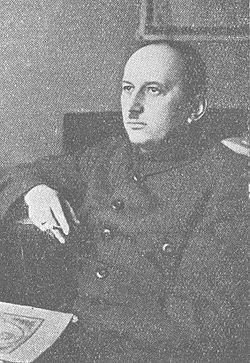Alexander Svechin
Imperial Russian Army and Soviet general (1878–1938) From Wikipedia, the free encyclopedia
Alexander Andreyevich Svechin (Russian: Александр Андреевич Свечин; 17 August 1878 – 28 July 1938) was a Russian and Soviet military leader, military writer, educator, and theorist, and author of the military classic work Strategy.
Alexander Svechin | |
|---|---|
 Svechin, ca. 1923 | |
| Academy of General Staff of the Red Army | |
| Personal details | |
| Born | Alexander Andreyevich Svechin Александр Андреевич Свечин 17 August 1878 Odessa, Kherson Governorate, Russian Empire |
| Died | 28 July 1938 (aged 59) Moscow, Russian SFSR, Soviet Union |
| Nationality | Soviet |
| Profession | Soldier |
| Military service | |
| Allegiance | Russian Empire Russian SFSR Soviet Union |
| Branch/service | Russian Imperial Army Red Army |
| Years of service | 1899–1938 |
| Battles/wars | Russo-Japanese War World War I Russian Civil War Soviet–Japanese Border Wars |
Early life
He was born in Odessa, where his father was a general in the Imperial Russian Army. He was of Russian ethnicity.[1] His elder brother Mikhail Svechin (1876–1969) was a cavalry officer in the cuirassiers who fought in the Russo-Japanese War and World War I, joined the White movement in the Russian Civil War and died in France in 1969.
He studied at St. Petersburg Cadet Corps, then in the Mikhailovsky Artillery School. He graduated from the General Staff Academy in 1903.[citation needed]
Career
Summarize
Perspective
He participated in the Russo-Japanese War of 1904-1905 as a Company Commander in the 22nd Eastern Siberian Regiment, and subsequently as a staff officer at the headquarters of the 16th Army Corps, and a staff officer at the headquarters of the 3rd Manchurian Army.
In 1915, he was assigned the command of the 6th Finnish Regiment, and was later named Chief of Staff of the 7th Infantry Division, commander of the Black Sea Marine Division, major general in 1916 and finally chief of staff of the Russian 5th Army.
Following the October Revolution, he joined the Bolsheviks in March 1918 and was immediately appointed military commander of the Smolensk region. He rose to become the head of the All-Russian General Staff.
In October 1918, disagreements with the Soviet commander-in-chief Jukums Vācietis caused Svechin to be removed from his position and to be appointed professor at the Academy of General Staff of the Workers' and Peasants' Red Army. The new position enabled Svechin to combine his talent as a writer with his knowledge of military strategy. His work Strategy became required reading at Soviet military schools.
In February 1931, in a purge of former tsarist officers in the Red Army, Svechin was arrested and sentenced to five years imprisonment in the gulags. However, in February 1932, he was released and returned to active duty as a divisional commander in the Red Army. He was posted first at the intelligence agency of the General Staff and then at the Academy of General Staff of the Red Army.
Death
Svechin was arrested on 30 December 1937 during the Great Purge. His name was included in death list No. 107, dated 26 July 1938 and signed by Joseph Stalin and Vyacheslav Molotov. On 29 July 1938, he was sentenced to death by the Military Collegium of the Supreme Court of the Soviet Union on charges of "participating in a counter-revolutionary organization" and "training terrorists".[2] According to historian Alexander Hill, Svechin was executed on 29 August 1938,[2] and his body buried in the Moscow region of Kommunarka.
He was rehabilitated within the framework of Mikhail Gorbachev's policy of glasnost. In 2013, Svechin's contribution to military theory was praised by Russian General Staff Chief Army General Valery Gerasimov.[3]
His name appears in Aleksandr Solzhenitsyn's cycle of novels The Red Wheel. Also, Solzhenitsyn's The Gulag Archipelago, in its French edition,[4] gives 1935 as the year of Svechin's execution.
Works
- Kokoshin, Andrei Afanasievich; Larionov, Valentin Veniaminovich; Lobov, Vladimir Nikolayevich; Kipp, Jacob W. (2004) [1923, 1927]. Introduction. Strategy. By Svechin, Alexander Andreevich. Lee, Kent D. (ed.). Minnesota: East View Information Cervices. ISBN 1-879944-33-2.
- "The Art of Regiment Leadership", Moscow, 1930 (in Russian)
References
Sources
Wikiwand - on
Seamless Wikipedia browsing. On steroids.
